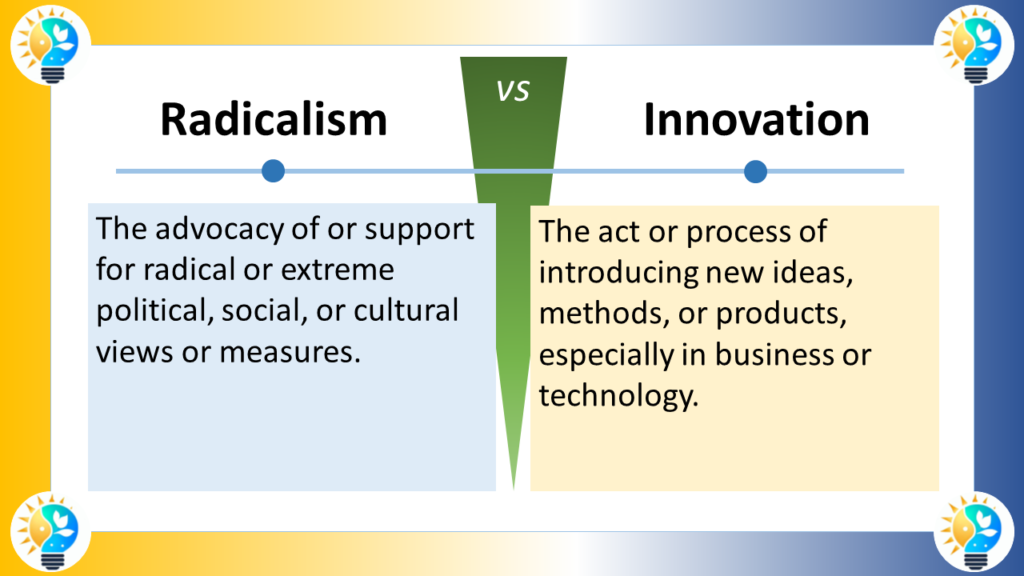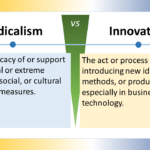The difference between innovation and radicalism centers around the nature of change each term represents.
Innovation refers to the introduction of new ideas, devices, or methods that aim to improve upon or replace existing standards.
Radicalism is characterized by advocating for complete political or social reform, which often involves changes that are more fundamental and sweeping in nature.

Definition
Innovation
Innovation entails the development and application of ideas and technologies that improve goods, services, or processes.
- Characteristics of Innovation:
- Creativity: Emphasizes original ideas and thinking.
- Improvement: Focuses on enhancing or updating current systems or products.
- Market Introduction: Often associated with the commercialization of new concepts.
Radicalism
Radicalism embodies the beliefs or actions of individuals, groups, or parties who call for thorough or complete political or social reform.
- Characteristics of Radicalism:
- Fundamental Change: Seeks to alter the basic structure of society or government.
- Extremism: Can sometimes involve extreme views or measures.
- Systemic Overhaul: Aims for a comprehensive transformation of the current system.
More Synonyms on innovation, innovate and innovative
Innovation Terms

Innovation is considered as a driving force in progress.
It includes the introduction of novel ideas, methods, or products that bring positive change and advancement.
For more information about innovations, check our glossary
Relationship and Relevance
Innovation and radicalism can intersect when innovative ideas are radical in their implications for society or an industry. Innovations can be radical if they significantly disrupt existing systems or paradigms. Conversely, radical ideas may require innovative approaches to be actualized. However, innovation typically operates within existing systems, seeking to enhance them, while radicalism often seeks to replace existing systems entirely.
Innovation
- Innovation is the broad process of creating something new that provides value, whether it is a new product, service, business model, or process.
- Innovation can range from incremental improvements to existing offerings to more radical, disruptive changes.
- Innovators work on developing new ideas and technologies that can lead to future disruptions.
Radicalism
The search results do not directly address the concept of "radicalism" in the context of innovation. However, we can infer some key differences based on the information provided:
- Radicalism typically refers to extreme or revolutionary views and actions, often associated with political or social change.
- In the context of innovation, radicalism would likely refer to innovations that involve fundamental, transformative changes, rather than incremental improvements. [Implied from the discussion of "radical innovation"]
- Radical innovations "stem from the creation of new knowledge and the commercialization of completely novel ideas or products" and can "displace current products, invent completely new products, or revolutionize entire industries."
- Radical innovations carry higher risk and uncertainty compared to more incremental innovations, but also have the potential for greater impact and disruption.
In summary, while innovation encompasses a broad range of new ideas and improvements, radicalism in the context of innovation would refer to the most transformative, disruptive, and revolutionary types of innovations that fundamentally change industries and societal norms. The search results do not directly address radicalism, but the concept of "radical innovation" provides some insight into how it differs from the broader notion of innovation.
Context for Using Each Term
- Innovation is typically used in business, technology, and science to describe new ideas that are brought to practical use.
- Radicalism is more commonly used in political, social, and economic contexts to describe the desire for sweeping changes to the status quo.
Example of Utilization
A company that invents a new type of solar panel that significantly reduces the cost of renewable energy is engaging in innovation. A political movement that seeks to completely restructure society's approach to energy consumption, moving away from a capitalist model to a communal one, can be described as radicalism.
In summary, innovation is about introducing and implementing new ideas to improve or replace existing methods or products, often with a focus on progressive change. In contrast, radicalism is about advocating for deep-seated change, which can sometimes challenge or overturn existing frameworks or ideologies.
- Radical Innovation
- Disruptive vs. Radical Innovation
- Innovation vs. Progress: Are We Losing Sight of What Really Matters?
- Do You Know the Difference Between Radical and Disruptive Innovation?
- What 40 Years of Research Reveals About the Difference Between Disruptive and Radical Innovation
FAQ
Q1: Can innovation be radical?
A1: Yes, some innovations, particularly disruptive innovations, can be considered radical if they fundamentally change existing systems or practices.
Q2: Is radicalism always negative?
A2: Not necessarily. While often controversial, radical changes have sometimes led to positive societal transformations, such as civil rights movements.
Q3: How do businesses balance innovation and avoid being perceived as radical?
A3: Businesses often focus on innovation that creates value within existing market structures, rather than advocating for fundamental systemic changes that might be seen as radical.
Q4: Can radicalism lead to innovation?
A4: Yes, radical thinking can sometimes inspire innovative solutions, particularly when addressing complex societal challenges.
Q5: Are certain fields more prone to innovation or radicalism?
A5: While innovation can occur in any field, technology and business often emphasize innovation. Radicalism is more commonly associated with politics, social movements, and sometimes philosophy or art.

